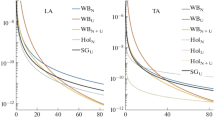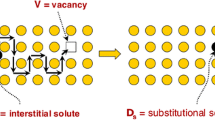Abstract
Germanium is an important element in semiconductor and microelectronics industries. Its thermal conductivity is an invariable and isotropic parameter in germanium crystal in the same temperature and its thermal conductivity is difficult to be measured in thin film. In the present paper, using the non-equilibrium molecular dynamics simulation method and Stillinger–Weber potential model, the normal and tangential thermal conductivity of germanium thin film are studied. There are remarkable anisotropy and size effect of thermal conductivity in normal and tangential direction of germanium thin film. In the theoretical analysis, Boltzmann transport theory is used to analyze the phonon transport in germanium thin film. Theoretical results further demonstrate the anisotropy and size effect of thermal conductivity in thin film, which indicate the significant decrease of phonon mean free path and predominant boundary phonon scattering in germanium thin film.






Similar content being viewed by others
Abbreviations
- A :
-
Heat transfer area potential experiment parameter
- B :
-
Potential experiment parameter
- c :
-
Heat specific per unit volume
- d :
-
Thickness of thin film
- ΔE k,in :
-
High temperature wall heat quantity
- ΔE k,out :
-
Low temperature wall heat quantity
- F ij :
-
Acting force of atom j on atom i
- F :
-
Decrement gene
- k :
-
Thermal conductivity
- k B :
-
Boltzmann constant number
- L b :
-
Casimir length of the crystal
- l :
-
Phonon mean free path
- m :
-
Atom mass
- N L :
-
The atom number in L layer
- r ij :
-
Distance of atom i and j
- r cut :
-
Cutoff distance of the potential
- R :
-
Dubey model experiment parameter
- T L,MD :
-
Average temperature in L layer
- T w :
-
Reservoir temperature
- t :
-
Time step
- U :
-
Total potential
- u :
-
Potential
- v :
-
Atom velocity
- ∇T :
-
Temperature gradient
- σ :
-
Potential experiment parameter
- τ :
-
Relaxation time
- α :
-
Wall scattering energy transmission coefficient
- δ :
-
Reduced thickness, δ = d/l ∞
- η :
-
Potential experimental parameter
- γ :
-
Potential experimental parameter
- θ jik :
-
Angle between r ij and r ik
- θ1, θ2, θ3, θ4 :
-
Integration parameters
- ω1, ω2:
-
Transverse phonons frequencies
- ω1, ω4:
-
Longitudinal phonons frequencies
- i, j, k:
-
Different atom
- T:
-
Transverse phonons
- L:
-
Longitudinal phonons
- eff :
-
Film valid parameter
- ∞:
-
Bulk crystal parameter
- w:
-
Reservoir or wall
- C, T:
-
Combined relaxation rates for transverse phonons
- C, L:
-
Combined relaxation rates for longitudinal phonons
- T1, T2:
-
Transverse phonons
- L1, L2:
-
Longitudinal phonons
References
Zhong H, Lukes JR (2006) Interfacial thermal resistance between carbon nanotubes: molecular dynamics simulations and analytical thermal modeling. Phys Rev B 74:125403-1–125403-10
Stevens RJ, Zhigilei LV, Norris PM (2007) Effects of temperature and disorder on thermal boundary conductance at solid–solid interfaces: nonequilibrium molecular dynamics simulations. Int J Heat Mass Transf 50:3977–3989
Tang Y, Huang Z, Wang X, Zheng X (2006) Molecular dynamics simulations of thermal conductivity of silicon nanotubes. J Comput Theor Nanosci 3:824–829
Wang Z, Li Z (2006) Lattice dynamics analysis of thermal conductivity in silicon nanoscale film. Appl Therm Eng 26(17–18):2063–2066
Wang Z, Li Z (2006) Research on the normal thermal conductivity of nanometer silicon film. Thin Solid Films 515:2203–2206
Han XJ, Chen M, Guo ZY (2004) Molecular dynamics simulation of thermophysical properties of undercooled liquid cobalt. Condens Matter Phys 16:2565–2574
Sun L, Murthy JY (2006) Domain size effects in molecular dynamics simulation of phonon transport in silicon. Appl Phys Lett 89(17):171919-1–171919-3
Berber S, Kwon YK, Tomanek D (2000) Unusually high thermal conductivity of carbon nanotubes. Phys Rev Lett 84(20):4613–4616
Maeda A, Munakata T (1995) Lattice thermal conductivity via homogeneous nonepuilibrium molecular dynamics. Phys Rev E 52(1):234–239
Stillinger F, Weber T (1985) Computer simulation of local order in condensed phases of silicon. Phys Rev B 31:5262–5271
Volz SG, Chen G (2000) Molecular-dynamics simulation of thermal conductivity of silicon crystals. Phys Rev B 61:2651–2656
Schelling PK, Phillpot SR, Pawel K (2002) Comparison of atomic-level simulation methods for computing thermal conductivity. Phys Rev B 65:144306-1–144306-12
Dubey KS (1980) Analysis of lattice thermal conductivity and phonon–phonon scattering relaxation rate: application to Ge. J Therm Anal 19:263–288
Dubey KS, Misho RH (1977) A new approach to lattice thermal conductivity: application to Ge. J Therm Anal 12:223–233
Ziman JM (1979) Principles of the theory of solids. Cambridge University Press, England
Sondheimer EH (2001) The mean free path of electrons in metals. Adv Phys 1:1–42
Acknowledgments
The authors appreciate the support of Major State Basic Research Development Program of China (2009GB104001) and Dean Fund of Graduate University of Chinese Academy of Sciences (085101DM03).
Author information
Authors and Affiliations
Corresponding author
Rights and permissions
About this article
Cite this article
Wang, Z.H., Ni, M.J. Thermal conductivity and its anisotropy research of germanium thin film. Heat Mass Transfer 47, 449–455 (2011). https://doi.org/10.1007/s00231-010-0731-2
Received:
Accepted:
Published:
Issue Date:
DOI: https://doi.org/10.1007/s00231-010-0731-2




